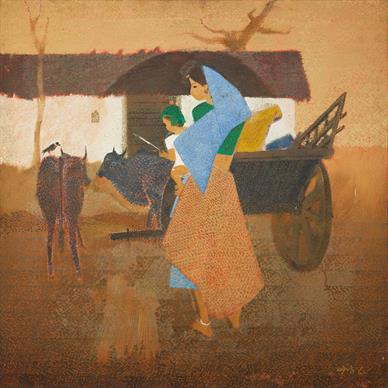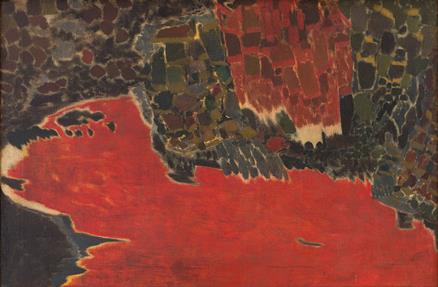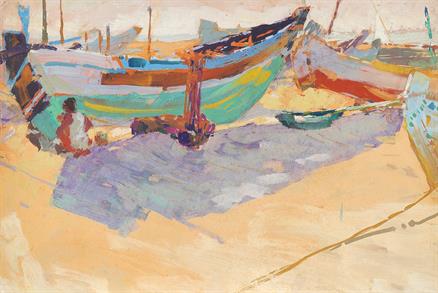Narayan Sridhar Bendre: A Pointillist Pioneer in Indian Modern Art
By Arun Kumar Ghosh

Introduction
This great heritage of the Indian Art boasts the glorious list of the Talented Artists who have coloured their canvas through different approaches and ideas. One such master of well-known Modern International Artists hails from India and is surely Narayan Sridhar Bendre (1910-1992), an Artist whose artwork is distinguished by sheer finesse, burst of colours and rich texture. Being a master of pointillistic style, Bendre did influence the Contemporary Art of India in a special way and at the same time, he remains as an Artist who is rooted in the Indian soil and culture as they are echoed in his creations.
The Pointillist Technique: The Celebration
The technique which originated with Impressionists known as Pointillism was developed by two well-known artists Georges Seurat (French) and Paul Signac (French) and it entails a use of small points of colours to form an image. This is a practice that Narayan Sridhar Bendre was quick to adopt while at the same time giving his own Indian twist to the method. That is why his love for combining the nature of this complex technique and the depiction of the daily life of people creates an opportunity for the viewer to touch his art with their hands.
One can differentiate specifically how Bendre uses pointillistic brushwork that lends a certain level of dynamism to every artwork. The systematic arrangement of dots compels attention resulting in what is aesthetically appealing as a mosaic and which forces the audience to focus on a work of art. Thus, with every glance, a completely different story appears – coloured dots bring together a familiar object, but at the same time, they do not actually represent it, as, from afar, they look like a pointless configuration, thus helping to establish a play between extremities, where one can see detail and ambiguity simultaneously.
Textural Richness
N S Bendre mentioned the idea of the Layered Experience as a concept that has to do with the cumulative effects of the interaction of a person with an object. One of the most important aspects when it comes to Bendre is that he is most engrossed in depicting textural complexity. He best administers the brush and gives the feel or touch to his work that would make them quite profound. That is due to the difference of the layer thickness, which, in turn, provokes a sense of touch that surpasses the concept of vision. His canvases are often painted in such a way that it appears to be a web of colours and patterns like in nature.
Emphasis on touch and seeing can thus be seen as parallel strings, connected and intersecting, in Bendre’s works. And the manner in which he plays smooth and rough areas makes him knowledgeable about the materiality of his landscapes and expressiveness. It is not the content that becomes the result of fascination but the becoming-surface of the artwork that forms an invitation to the viewer to look further into the presented piece. If one looks carefully enough, he or she will discover a countless number of subtleties – one shade smoothly giving way to another, one dot group being much denser than the other, one luminous area gently overlapping with the neighboring darker one, and so on – all these giving vital energy to the piece in question.
Colour Palette: The Sentiments of the Craftsmanship
Moving up, colour in N S Bendre’s works is not the same as filler or ornamentation; it forms the spirit of what he does. He frequently uses colours inspired by natural, global surroundings that most probably appeal to the richness of an Indian countryside. Every single colour is relevant in terms of the emotions they put across, the story they tell, and the ambience created. Ranging from bright, warm citrus and dusted browns to dark naval and fresh grass green, every tint is put with precision to form a balanced picture.
The artist lays great emphasis on the choice of colours; he knows how the colours can influence the feeling of people and transforms them from the feelings of calmness up to joy. Thus, the use of cool and warm tones may help provide depth and push the viewer inside the painting. While selecting the colours to apply on the painting surface, Bendre uses complementary colours; an element that results in electrifying vibrancy or visual symphony seen to be dancing on the painting surface. This communication through colour is nothing short of an appeal to all the senses of the audience, thereby encouraging them to touch, to taste, to hear the nature as Bendre seems to.
A Cultural Resonance: Bridging the Traditions
The features that can be credited to Narayan Sridhar Bendre are the great blending of the modern styles and painting sensibilities that have been seen in Indian art. It is important to note that pointillism itself is of Western origin albeit Bendre has been able to successfully bring a synonymous ethnicity feel to the paintings. This way, his works were able to apply the most beautiful balance between Tradition and Modernity and thus they are as universally comprehensible as possible.
The relationship with the geographical representation of India is present significantly in Bendre’s works depicting the rustic essence. Tones of home and belonging are thus elicited among viewers by the scenes of fields, rivers, and villages. His focus on these elements does not only retain and safeguard the tales of the heritage but also raises it to the ranking of art of the contemporary world. Thus, by bringing and updating the traditional themes, Bendre can become a linking figure between the past and the present in the context of Indian art.
An Artistic Legacy
The ‘Conversation’ – a painting by Narayan Sridhar Bendre speaks Volume for the effect that Bendre had on Indian art and his ability to go as advanced as even using pointillism, different textural methods, and choice of colours. His artworks are not only the sight; it is an appeal for touch, appeal to emotionally touch the senses of the viewers and appeal for a touching manifestation that symbolizes life in one hue or the other on his canvases. It is only when one starts exploring Bendre’s creations that one is reminded of the beauty that lays in details, the passion found in the use of colours and the undertones that identify the craftsman’s art alongside the richness of Indian culture.
In the contemporary world that seems to be progressing toward globalization of art, N S Bendre’s works are the reminders that the cultural individuality is the power that should not be overshadowed but enhanced with innovation. Even in this contemporary generation, many artists and art lovers emulate his works and ideas that show the beauty born out of the harmony of Tradition and Innovation. Living a legacy with a truly Indian twist, Narayan Sridhar Bendre can always be cherished as one of the most outstanding Masters of Modern Indian Art.













0 Comments